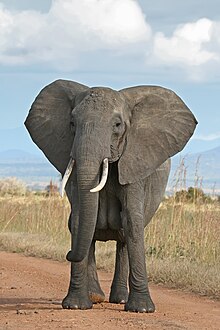
Back Savanne-olifant Afrikaans Loxodonta africana AN فيل الأدغال الإفريقي Arabic فيل الادغال الافريقى ARZ Африкаялъул пил AV Fuzol (Loxodonta africana) AVK Afrika savanna fili Azerbaijani Саваннавы слон Byelorussian Саванавы афрыканскі слон BE-X-OLD Африкански саванен слон Bulgarian
| African bush elephant Temporal range:
| |
|---|---|

| |
| A female in Mikumi National Park, Tanzania | |
| Scientific classification | |
| Domain: | Eukaryota |
| Kingdom: | Animalia |
| Phylum: | Chordata |
| Class: | Mammalia |
| Order: | Proboscidea |
| Family: | Elephantidae |
| Genus: | Loxodonta |
| Species: | L. africana[1]
|
| Binomial name | |
| Loxodonta africana[1] (Blumenbach, 1797)
| |
| Subspecies | |
|
See text | |

| |
| Range of the African bush elephant Resident Possibly resident Possibly extinct Resident and reintroduced
| |
| Synonyms | |
|
Elephas africanus | |
The African bush elephant (Loxodonta africana), also known as the African savanna elephant, is one of two extant African elephant species and one of three extant elephant species. It is the largest living terrestrial animal, with bulls reaching an average shoulder height of 3.04–3.36 metres (10.0–11.0 ft) and a body mass of 5.2–6.9 tonnes (11,500–15,200 lb), with the largest recorded specimen having a shoulder height of 3.96 metres (13.0 ft) and a body mass of 10.4 tonnes (22,900 lb).[3]
It is distributed across 37 African countries and inhabits forests, grasslands and woodlands, wetlands and agricultural land. Since 2021, it has been listed as Endangered on the IUCN Red List. It is threatened foremost by habitat destruction, and in parts of its range also by poaching for meat and ivory.[2]
It is a social mammal, travelling in herds composed of cows and their offspring. Adult bulls usually live alone or in small bachelor groups. It is a herbivore, feeding on grasses, creepers, herbs, leaves, and bark. The menstrual cycle lasts three to four months, and females are pregnant for 22 months, the longest gestation period of any mammal.[4]
- ^ Shoshani, J. (2005). "Order Proboscidea". In Wilson, D.E.; Reeder, D.M (eds.). Mammal Species of the World: A Taxonomic and Geographic Reference (3rd ed.). Johns Hopkins University Press. p. 91. ISBN 978-0-8018-8221-0. OCLC 62265494.
- ^ a b c Gobush, K.S.; Edwards, C.T.T.; Balfour, D.; Wittemeyer, G.; Maisels, F. & Taylor, R.D. (2021) [amended version of 2021 assessment]. "Loxodonta africana". IUCN Red List of Threatened Species. 2021: e.T181008073A204401095. doi:10.2305/IUCN.UK.2021-2.RLTS.T181008073A204401095.en. Retrieved 15 January 2022.
- ^ Cite error: The named reference
probos_masswas invoked but never defined (see the help page). - ^ Foley, C. A. H.; Papageorge, S.; Wasser, S. K. (3 August 2001). "Noninvasive Stress and Reproductive Measures of Social and Ecological Pressures in Free-Ranging African Elephants". Conservation Biology. 15 (4): 1134–1142. Bibcode:2001ConBi..15.1134F. doi:10.1046/j.1523-1739.2001.0150041134.x. ISSN 0888-8892. S2CID 84294169.
Cite error: There are <ref group=note> tags on this page, but the references will not show without a {{reflist|group=note}} template (see the help page).
